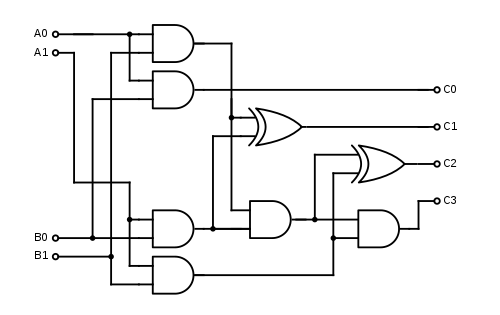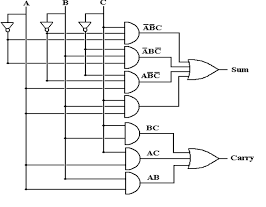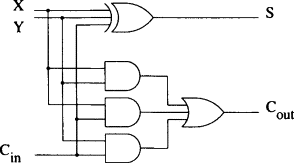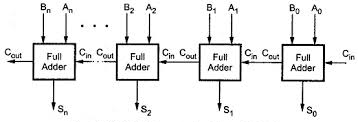With the advent of electronics and computers learning binary numbering systems and operations with operation numbers have gained a lot of importance. Since all the computer operations work on a binary system, it has become important to know how arithmetic calculations are performed on binary numbers. These operations must be in line with the traditional arithmetic rules of performing basic math functions on numbers. This article discusses binary addition, which is one of the fundamental operations of binary numbers.
What is Binary Addition?
Definition: Binary addition can be defined as the method of adding two binary numbers. It follows a set of rules to add binary numbers. The rules are framed such as, whatever the result we are getting in binary addition, the same we should get when we are doing the traditional arithmetic addition. By doing binary addition, two numbers in their binary are added to get the resultant number. The rules for the binary addition are defined as follows
Binary addition is a method of adding two binary numbers. Every integer can be represented in binary form. Binary addition discussed the rules of adding two numbers in their binary form. First, a number is represented in its binary form. For example, the binary equivalent of the first ten numbers has been shown below.

Binary Equivalent
In this manner, any number can be represented in its binary equivalent. In the above figure, the four-digit representation of the binary number has been shown. Similarly, we can have n bit representation of any number. These are derived by assigning weights to each digit. In binary representation, we assign weights as the power of two. From the rightmost side, they are assigned as 1,2,4 and 8.
Binary Addition Truth Table
The truth table or formula for binary addition is given, as shown below

Binary Addition Truth Table
Rules for Binary Addition
The rules, while adding the binary numbers are
- The addition is always started from the rightmost side.
- When zero and zero are added, the sum remains zero, and the carry also remains zero. There is no increment in the overall value.
- When zero and one are added, the sum is one, however, the carry remains zero. Overall value is incremented by one.
- The third case, when one and zero are added, is the same as the before case. That is, the sum is one, and carry remains zero. The overall value is incremented by one.
- The last case is when one and one are added. In this case, the sum is zero, however, the carry is one. This carry is taken to the next column for addition. In case there are no numbers in the next column, the carry is taken into for the result. It is directly placed in the results. Overall value is incremented by one in this case also.
Binary Addition of Decimal Numbers
Let us see the following example of binary addition.

Binary Addition
In the example, two numbers 1010 and 0010 are added. The addition is always started from the left-most side. First zero and zero are added. The sum is 0 and the carry is zero. The result is zero in this case. Then we move on to the next one. One and one are added. In this case, the sum is zero, however, carry one is taken to the next column. For the next edition, we have zero and zero, plus a carry of one from the previous edition. The result becomes one. For the last addition, one is added to zero.
The sum is one with no carry. Therefore, the result is 1100. The same can be verified by doing the binary conversion. The decimal equivalent of the first number 1010 is 10. And the second number 0010 is 2. Addition of both results in 1100 which is equivalent to 12. Hence our binary addition is correct. In this manner, it can be verified, by doing the binary addition of decimal numbers.
Binary Addition using One’s Compliment
Now we will see how to add two binary numbers using one’s complement. In general, the one’s complement method is used to represent the negative numbers. One’s complement method is used to add one positive and negative number. Let us see the example. Let us say we want to add, 2 and -1. The sum would be 1. Let us check this by doing one’s complement method.

One’s Complement Method
The binary equivalent of two is 0010. And the binary equivalent of -1 is calculated by doing the one’s complement method. For this first binary equivalent of 1 is calculated. Which is equal to 0001. Then to calculate the one’s complement, since it is a negative number, all the digits are complemented. This means, zero is represented as one, and one is represented as zero. Therefore, it becomes 1110. Then the addition is done as

Binary Addition by One’s Complement
As seen in the figure, first the two numbers 0010 ad 1110 are added usually. We get the result, 0000 with one carry. This extra carry which is the fifth digit is taken to the extreme left, and the final answer becomes 0001. We can verify the same by doing the binary conversion. The equivalent of 0010 is 2, and 1110 is -1. The result is 0001, whose decimal equivalent is 1.
Binary Addition with Two’s Complement Method
For doing the binary addition using two’s complement method, first, we need to understand the signed magnitude. The signed magnitude is used to represent a sign of a number.
Signed Magnitude
The signed magnitude is used to represent the sign of a number. Consider the following figure.

Signed Magnitude
In the above figure, +6 is represented as 0110. In the representation, the last three numbers 110 represent the magnitude. Whereas the first number 0 represents the sign. So for +6, it is represented as 0110. Similarly, for -6 since the sign is negative, the first number is replaced with 1 in place of 0. Hence it becomes 1110. In the same manner, -7 would be represented as 10111, -5 would be represented as 1101, etc. It could be noted that to represent -7 and above, we need 5 digit representation. This fact comes from the point that it is equal to 2 to the power n -1.
Two’s Complement of a Number
As we have seen that one’s complement is used to represent a negative number, similarly the two’s complement is used to represent the negative number. Consider the following figure.

Two’s Complement
As seen from the figure, the binary representation of -7 is given as 0111. Then it’s one complement is found by complementing the numbers. Which is equal to 1000. Then to find the two’s complement, the number 1000 is added to 1. Whose value becomes 1001. This is the two’s complement of -7. This is how to find the two’s complement of a number.
Binary Addition by using Two’s Complement
Now let’s see, how to add two numbers, using two’s complement. Let see the following figure.

Binary Addition by Two’s Complement
In the above example, two numbers, +6 and +7 are added by using the two ‘s complement method. Firstly they are represented in a five-digit format. For which the MSB or magnitude sign bit is taken into consideration. So first bit represents the magnitude. Since it is +6 so we have considered the 0 for it. The rest of the addition is similar to the normal binary addition which we have seen before.
Two Bit Binary Adder
A two-bit binary adder circuit is shown below

Two Bit Binary Adder
A two-bit adder circuit can be realized using Ex-OR gates and AND gates. As shown in the figure, the binary addition is realized as the binary addition is equivalent to the Ex-OR gate truth table. The Ex-OR gate truth table is shown below. It is the same as binary addition. And for carrying, the AND gates are used, as shown in the figure. The AND gate is used to realize the carry. This is how a two-bit adder is realized.
Three Bit Binary Adder
A three-bit binary code is shown in the following figure.

Three Bit Binary Adder
A three-bit adder circuit, adds parallel three bits at the same time. As shown in the figure, a three-bit adder is realized using EX-OR gates and AND gates. A three-input AND is shown below for understanding the circuit. It could be noted that a three-bit adder circuit can be together realized as a Full adder circuit. A full adder circuit is shown in the figure. As shown in the figure, a three-bit adder is realized using a full adder circuit.

As shown, X, Y, and Cin act as three inputs. The output S is the addition of the three inputs, and Cout is for the carrier that is taken forward to the next column. A full adder circuit can also be realized by adding two half adder circuits.
n-bit Parallel Adder
An n-bit parallel adder is shown in the following figure.

n-bit Parallel Adder
For the realization of the n-bit parallel adder, n number of full adder circuits are cascaded and connected. For example for the realization of a 4-bit adder, we can have 4 stages cascaded. This means that four full adder circuits can be connected in a cascade.
Similarly, 5-bit adder, 6-bit adder, 7-bit adder, and 8-bit adder can be realized using the above circuit. The logic for implementing remains the same, as that for a full adder circuit. We have one output node for sum and one output node for carrying. The Cin becomes the input terminal for the next stage.
Please refer to this link to know more about Binary Addition MCQs
Binary Addition Overflow
In binary addition, one can have an overflow of the carry. An example of binary overflow is shown in the figure.

Binary Overflow
In the above diagram, for the last column, when the carry is taken to the next column, it is said to be overflow. In such cases, the carry is taken to the last number and placed at the least significant place. As we can see, 10000, becomes 0001. For such circuits, binary addition overflow circuits can also be designed. One of the common applications of logic gates can be found in multiplexer circuits.
What is binary addition used for?
Ans. In computer calculations, it is necessary to perform operations on binary numbers. A simple example is a calculator. So to design such circuits, where input is in digital form, we need binary addition.
How binary addition is performed?
Ans. For performing binary addition, a set of rules are followed, based on which logic gates are designed. The simple logic for adding two numbers is when one of the inputs is high, the output is high. And if both the inputs are low, the output is low and both the inputs are high, the output is high. This is formulated in a sum and carried later.
What is overflow when adding binary?
Ans. Overflow happens when the result does not fits into the designated bits or doesn’t fit into the range of numbers, which are used to represent n bit numbers. Display overflow happens if the result in too large to fit in the n-bit group of numbers.
Hence, we have seen the principle of binary addition and rules to carry out. With the advent of technology, small circuits, compassing the adders and subtraction circuits can easily be designed. Here is a question for you, what is binary subtraction?